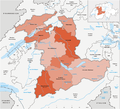
The canton of Bern, or Berne, is one of the 26 cantons forming the Swiss Confederation. Its capital city, Bern, is also the de facto capital of Switzerland. The bear is the heraldic symbol of the canton, displayed on a red-yellow background.
On 26 June 1964, Swiss Post introduced postal codes as the third country after Germany (1941) and the United States (1963).

There are 335 municipalities in the canton of Bern, Switzerland.

Aarwangen District is a constitutional district in the northeast corner of the canton of Bern in Switzerland, with its seat at Aarwangen. From 1 January 2010, the district lost its administrative power. Since 2010, it remains a fully recognised district under the law and the Constitution of the Canton of Berne. Its municipalities became part of the administrative region Emmental-Oberaargau.
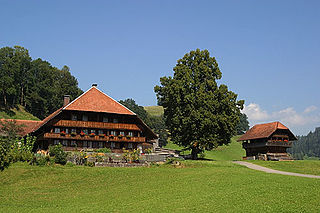
The Emmental is a valley in west-central Switzerland, forming part of the canton of Bern. It is a hilly landscape comprising the basins of the rivers Emme and Ilfis. The region is mostly devoted to farming, particularly dairy farming. The principal settlements are the town of Burgdorf and the village of Langnau.

Districts of Switzerland are a political subdivision for cantons. In the federally constituted Switzerland, each canton is completely free to decide its own internal organisation. Therefore, there exists a variety of structures and terminology for the subnational entities between canton and municipality, loosely termed districts. Most cantons are divided into Bezirke. They are also termed Ämter, Amtsbezirke, district or distretto. The Bezirke generally provide only administration and court organization. However, for historical reasons districts in cantons Grisons and Schwyz are their own legal entities with jurisdiction over tax and often have their own Landsgemeinde.

Courtelary District is located in Switzerland and is one of the three French-speaking districts of the Bernese Jura, along with La Neuveville and Moutier. The district is located in the canton of Bern with the seat being Courtelary. It had a population of about 22,224 in 2004. The three districts lost their administrative power and were merged on 1 January 2010 to form the new district of Jura Bernois with the capital at Courtelary.

The Bernese Oberland, sometimes also known as the Bernese Highlands, is the highest and southernmost part of the canton of Bern. It is one of the canton's five administrative regions. It constitutes the Alpine region of the canton and the northern side of the Bernese Alps, including many of its highest peaks, among which the Finsteraarhorn, the highest in both range and canton.
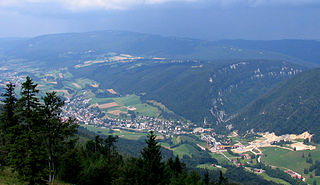
Bernese Jura is the name for the French-speaking area of the Swiss canton of Bern, and from 2010 one of ten administrative divisions of the canton.

Seeland is a region in Switzerland, at the south-eastern foot of the mountain range of the Jura Mountains containing the 3 Lakes of Morat, Neuchâtel, and Bienne (Biel). In previous eras, it was the floodplain of the Aare and was thus swampy. After the huge hydrological works Jura water correction, the area drained out and could support more cultivation. Seeland is one of the most important regions in Switzerland for growing vegetables, particularly in the Grand Marais.

BLS AG is a Swiss railway company created by the 2006 merger of BLS Lötschbergbahn and Regionalverkehr Mittelland AG. Its ownership is divided, with 55.8% of it owned by the canton of Berne, and 21.7% by the Swiss Confederation. It has two main business fields: passenger traffic and infrastructure.
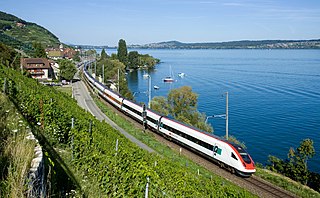
The Jura Foot Line or Jura South Foot Line, is a railway line in Switzerland. It runs from Olten along the foot of the southern Jura range through Solothurn, Grenchen, Biel/Bienne, Neuchâtel, Yverdon-les-Bains and Morges to Lausanne. It is one of two routes used by intercity trains between Geneva and Zürich. The other is the Midland line which connects Olten via Langenthal, Burgdorf, Bern, Fribourg, Lausanne to Morges. The line was built by five railway companies, which after several mergers were absorbed into the Swiss Federal Railways in 1903.
Seeland District in the Canton of Bern was created on 1 January 2010. It is part of the Seeland administrative region. It contains 42 municipalities with an area of 334.14 km2 (129.01 sq mi) and a population of 76,052.

The Bern S-Bahn is an S-Bahn commuter rail network focused on Bern, the capital city of Switzerland. The network is roughly coterminous with Bern's urban agglomeration.

The Lake Thun railway line is a railway line in the Swiss canton of Bern. It links the towns of Thun, Spiez and Interlaken, running principally along the southern shore of Lake Thun. The line was opened in 1893 by the Lake Thun Railway company, but incorporates much of the earlier Bödeli Railway dating back to 1872.
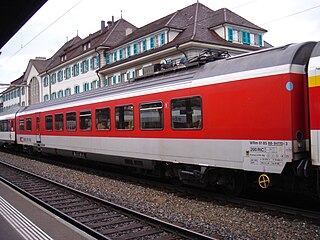
Thun is a railway station in the town of Thun, in the Swiss canton of Bern. At the station, the Swiss Federal Railways owned Bern to Thun main line makes a junction with the other lines, all owned by the BLS AG. These lines are the Gürbetal line from Bern via Belp, the Burgdorf to Thun line from Burgdorf via Konolfingen, and the Lake Thun line to Spiez and Interlaken.
The Evangelical Reformed Church of the Canton Bern-Jura-Solothurn is a Reformed state church in three cantons of Switzerland. It is located within the Canton of Bern, Canton of Jura, and Canton of Solothurn.
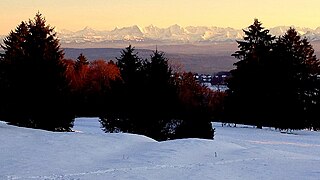
Tessenberg is an elevated plateau in Switzerland. It is located above Lake Biel, on the southern slopes of Chasseral, at an elevation of about 800 m. It is divided between the Swiss cantons of Bern and Neuchâtel, and three municipalities, Nods, Lignières and Plateau de Diesse.

Bern Europaplatz railway station is a railway station in the Swiss canton of Bern and city of Bern that is a major public transport interchange. The station has two levels and groups of platforms, with the upper one on the SBB-owned Olten to Lausanne line and the lower one on the BLS-owned Gürbetal line. Until 2014, the two groups of platforms were regarded as separate stations, known as Ausserholligen SBB and Ausserholligen GBS respectively, but in that year they were both renamed after the adjacent Zentrum Europaplatz and are now shown as a single station on public transport maps.





